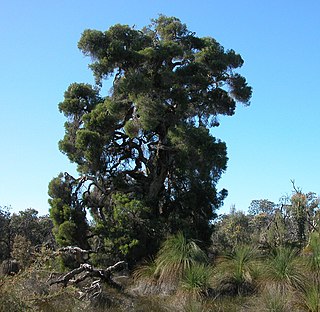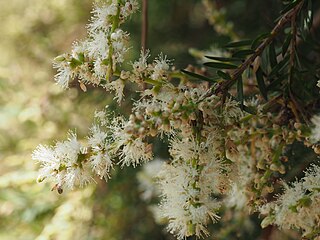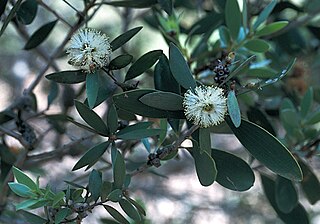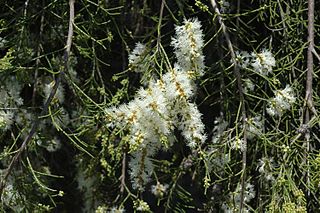
Melaleuca is a genus of nearly 300 species of plants in the myrtle family, Myrtaceae, commonly known as paperbarks, honey-myrtles or tea-trees. They range in size from small shrubs that rarely grow to more than 16 m (52 ft) high, to trees up to 35 m (115 ft). Their flowers generally occur in groups, forming a "head" or "spike" resembling a brush used for cleaning bottles, containing up to 80 individual flowers.

Melaleuca quinquenervia, commonly known as the broad-leaved paperbark, paper bark tea tree, punk tree or niaouli, is a small- to medium-sized tree of the myrtle family, Myrtaceae. It grows as a spreading tree up to 20 m (70 ft) tall, with its trunk covered by a white, beige and grey thick papery bark. The grey-green leaves are egg-shaped, and cream or white bottlebrush-like flowers appear from late spring to autumn. It was first formally described in 1797 by the Spanish naturalist Antonio José Cavanilles.

Melaleuca linariifolia is a plant in the myrtle family Myrtaceae, and is endemic to eastern Australia. It is commonly known as snow-in-summer, narrow-leaved paperbark, flax-leaved paperbark and in the language of the Gadigal people as budjur. A hardy plant, it flowers prolifically in late spring or summer, making it a popular garden shrub or small tree in temperate places. Melaleuca trichostachya is a similar species but its leaves are arranged differently and the fruits have projecting valves.

Melaleuca preissiana, commonly known as stout paperbark, modong or moonah, is a plant in the myrtle family, Myrtaceae and is endemic to coastal areas of southwest Australia. It is a shrub or small tree with papery bark, small leaves and spikes of usually white flowers. It occurs chiefly in areas that are seasonally wet.

Melaleuca leucadendra, commonly known as weeping paperbark, long-leaved paperbark or white paperbark is a plant in the myrtle family, Myrtaceae and is widespread in northern Australia, Southeast Asia, New Guinea and the Torres Strait Islands. It is a tree, sometimes growing to more than 20 m (70 ft) with a trunk covered with thick, white, papery bark and weeping thinner branches. It has a long flowering season, can flower at almost any time of the year and is often grown as a tree in parks and on roadsides. It was the first melaleuca to be described and was described from a specimen growing in Indonesia.

Melaleuca viridiflora, commonly known as broad-leaved paperbark, is a plant in the myrtle family Myrtaceae, and is native to woodlands, swamps and streams in monsoonal areas of northern Australia and New Guinea. It is usually a small tree with an open canopy, papery bark and spikes of cream, yellow, green or red flowers.

Melaleuca halmaturorum, commonly known as South Australian swamp paperbark, kangaroo honey-myrtle or salt paper-bark is a plant in the myrtle family, Myrtaceae and is endemic to Western Australia, South Australia and Victoria. It is often a tree with an unusual, crooked form, sometimes looking like an enlarged example of bonsai.

Melaleuca dissitiflora, commonly known as creek tea–tree, is a plant in the myrtle family, Myrtaceae and is native to Australia. It occurs in the drier parts of Queensland, the Northern Territory, South Australia and Western Australia. It grows in places like sandy creek beds and rocky gorges but it may have potential as a more productive source of "tea tree" oil than the usual Melaleuca alternifolia. It is closely related and very similar to Melaleuca linophylla with its papery bark, narrow leaves and loose spikes of creamy-white flowers but its flowers are larger, the stamens are longer and there are more stamens per bundle than in that species.

Melaleuca ericifolia, commonly known as swamp paperbark, is a plant in the myrtle family, Myrtaceae and the genus Melaleuca, native to south-eastern Australia. It is a rather variable species and some specimens resemble Melaleuca armillaris but its papery bark and smaller, more prolific flower heads distinguish it from that species. It often grows in swampy areas and the draining and clearing of these has reduced the numbers of the species, especially around Port Philip Bay near Melbourne. It is also similar to Melaleuca pustulata, a Tasmanian endemic, but that species only grows in dry heath.

Melaleuca acacioides, commonly known as coastal paperbark and as lunyamad by the Bardi people, is a plant in the myrtle family Myrtaceae, and is native to the far north of Australia and the island of New Guinea. It is closely related to Melaleuca alsophila and Melaleuca citrolens, being differentiated from them by the number of flowers in a group. In this species, they are in groups of three. It is a small to medium-sized tree, sometimes with several trunks when growing in the open. It usually grows in areas with saline soils that are regularly flooded, often near mangroves.

Melaleuca decora, commonly known as the white feather honeymyrtle, is a plant in the myrtle family, Myrtaceae and is native to eastern Australia. It is a large shrub to small tree with papery bark, lance-shaped leaves and sweet-smelling, creamy-coloured flowers in summer. It grows in near-coastal forest and swamps in New South Wales and Queensland.

Melaleuca argentea, commonly known as the silver cadjeput, silver-leaved paperbark, silver cajuput, or mardderr in the Kunwinjku language, is a plant in the myrtle family, Myrtaceae and is endemic to northern Australia. It is a common tree along river banks or around swamps in the tropics. It has papery bark and weeping foliage and has been the subject of important scientific research.

Melaleuca arcana is a small tree or large shrub in the myrtle family, Myrtaceae and is endemic to Cape York Peninsula in northern Australia. It has papery bark and small heads of white flowers in summer.

Melaleuca fluviatilis is a plant in the myrtle family, Myrtaceae and is endemic to northern Queensland in Australia. It is a tree with papery bark, narrow leaves and spikes of white or creamy-coloured flowers, usually growing along streams and rivers. It is common in tropical areas and is sometimes confused with Melaleuca argentea although it lacks that species' silvery foliage.

Melaleuca groveana, commonly known as Grove's paperbark is a plant in the myrtle family Myrtaceae and is endemic to New South Wales and Queensland in Australia. It is an uncommon species with relatively large heads of white flowers in spring, the styles of which are significantly longer than the stamens.

Melaleuca irbyana, commonly known as weeping paperbark, bushhouse paperbark and swamp paperbark, is a plant in the myrtle family Myrtaceae and is endemic to New South Wales and Queensland in Australia. It is a shrub or small tree, often growing in pure stands in poorly drained areas. Its distribution is limited and it has been classified as an endangered species under legislation in both states and the forest as critically endangered under Australian government legislation.
Melaleuca saligna is a shrub or tree in the myrtle family (Myrtaceae) and is endemic to Cape York Peninsula in Queensland. It is a small tree with papery bark on the trunk, pendulous branches and white to greenish-yellow flowers between February and November. This species should not be confused with Callistemon salignus. If that species were to be moved to the genus Melaleuca, as proposed by some authors, its name would become Melaleuca salicina. Melaleuca saligna has its stamens arranged in bundles; the stamens of Callistemon salignus/Melaleuca salicina are all free.

Melaleuca stenostachya, commonly known as fibre-barked teatree or straight teatree is a plant in the myrtle family Myrtaceae and is native to the Cape York Peninsula in northern Australia, the gulf country of the Northern Territory and the south of Papua New Guinea. It is closely related to Melaleuca dealbata but can be distinguished from that species by the wide separation of the flowers in the inflorescence.

Melaleuca tamariscina, commonly known as bush-house paperbark or tamarix honey-myrtle is a plant in the myrtle family, Myrtaceae and is endemic to central Queensland in Australia. It grows to the height of a small tree with small, scale-like leaves that are pressed against the branches, and has a papery bark and a weeping habit.
Melaleuca ferruginea is a plant in the myrtle family, Myrtaceae and is endemic to areas near the coast of the Northern Territory in Australia. It grows to tree size, its new bark is reddish-brown and papery, and its flowers are arranged in spikes new the ends of its branches.



















